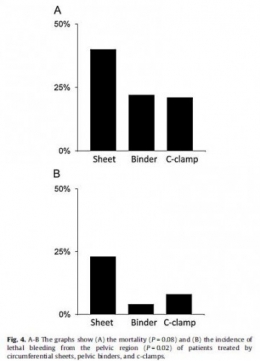Stabilisation pelvienne: Vraiment utile !
08/09/2013
Emergency stabilization of the pelvic ring: Clinical comparison between three different techniques
Pizanis A. et All. Injury. 2013 Aug 2. pii: S0020-1383(13)00316-1.
Background: Emergency devices for pelvic ring stabilization include circumferential sheets, pelvic binders, and c-clamps. Our knowledge ofthe outcome ofthese techniques is currently based on limited information.
Methods: Using the dataset of the German Pelvic Trauma Registry, demographic and injury-associated characteristics as well as the outcome of pelvic fracture patients after sheet, binder, and c-clamp treatment was compared. Outcome parameters included transfusion requirement of packed red blood cells, length of hospital stay, mortality, and incidence of lethal pelvic bleeding.
Results: Two hundred seven of 6137 (3.4%) patients documented in the German Pelvic Trauma Registry between April 30th 2004 and January 19th 2012 were treated by sheets, binders, or c-clamps. In most cases, c-clamps (69%) were used, followed by sheets (16%), and binders (15%). The median age was significantly lower in patients treated with binders than in patients treated with sheets or c-clamps (26 vs. 47 vs. 42 years, p = 0.01). Sheet wrapping was associated with a significantly higher incidence of lethal pelvic bleeding compared to binder or c-clamp stabilization (23% vs. 4% vs. 8%). No significant differences between the study groups were found in sex, fracture type, blood haemoglobin concentration, arterial blood pressure, Injury Severity Score, the incidence of additional pelvic packing and arterial embolization, need of red blood cell transfusion, length of hospitalisation, and mortality.
Conclusions: The data suggest that emergency stabilization ofthe pelvic ring by binders and c-clamps is associated with a lower incidence of lethal pelvic bleeding compared to sheet wrapping.



Les commentaires sont fermés.